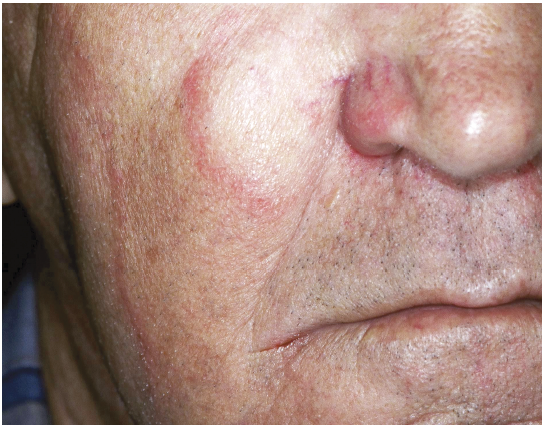Man With Refractory Rash

For several years, a 72-year-old man has had a slightly itchy rash on his face. The rash waxes and wanes but never quite resolves despite the use of over-the-counter hydrocortisone, triple antibiotic creams, and antifungal creams. It seems to worsen slightly during hot weather.
The patient does not work with or own any animals, and he has no direct contact with children. No one else in his household is similarly affected. He has rheumatoid arthritis, which is well controlled with methotrexate and low-dose prednisone.
Examination reveals a faintly annular fine papulosquamous rash affecting both sides of the face, as well as the back of the neck. Patches of somewhat similar rash are seen on the buttocks, around the waist, and in the crural folds. His feet, palms, and nails are uninvolved.
Given this clinical picture, what is the most practical next step?
A. Obtain a punch biopsy from the rash.
B. Refer the patient back to his rheumatologist.
C. Perform a potassium hydroxide (KOH) examination.
D. Order laboratory studies to check for lupus.
(Answer on next page.)
ANSWER: C, Perform a KOH examination.
A KOH examination (choice C) was performed, and multiple hyphal elements were seen, confirming the suspected clinical diagnosis of generalized dermatophytosis, which was probably perpetuated by the patient’s chronic immunosuppression with medication.
 A punch biopsy (choice A) would involve a surgical wound, sutures, and a scar, and it would show fungal elements only if the correct stain (periodic acid-Schiff) had been requested. In this case, the KOH examination was by far the more practical of the two choices. Had it been negative, a punch biopsy would be a reasonable next step.
A punch biopsy (choice A) would involve a surgical wound, sutures, and a scar, and it would show fungal elements only if the correct stain (periodic acid-Schiff) had been requested. In this case, the KOH examination was by far the more practical of the two choices. Had it been negative, a punch biopsy would be a reasonable next step.
Since this rash had been present for several years, the patient’s rheumatologist had seen it a number of times and had always referred the patient back to his primary care physician, so there was no reason to think the rheumatologist would be able to recognize the rash for what it was. Thus, choice B is incorrect.
A work-up for lupus (choice D) would have been reasonable (along with a punch biopsy) had the KOH examination been negative, but it was not the most practical next step to take.
TREATMENT AND PROGNOSIS
Treatment consisted of the following regimen:
•Oral terbinafine 250 mg a day for 2 weeks.
•Econazole cream applied bid to affected areas until clearing.
•Prescription-strength ketoconazole body wash used daily to reduce fungi on skin surfaces and prevent reinfection.
As long as the patient is taking immunosuppressant medications, however, his chances of a cure are slight.
DISCUSSION
While it is true that the differential diagnosis in this case included cutaneous lupus, contact dermatitis, and even vasculitis, the annular scaly morphology and extended chronicity suggested something more mundane. What gave this diagnosis away were the widespread involvement, annular papulosquamous border, and positive KOH examination, but the underlying issue was immune suppression, which answered the question of how the infection became so chronic and florid.


